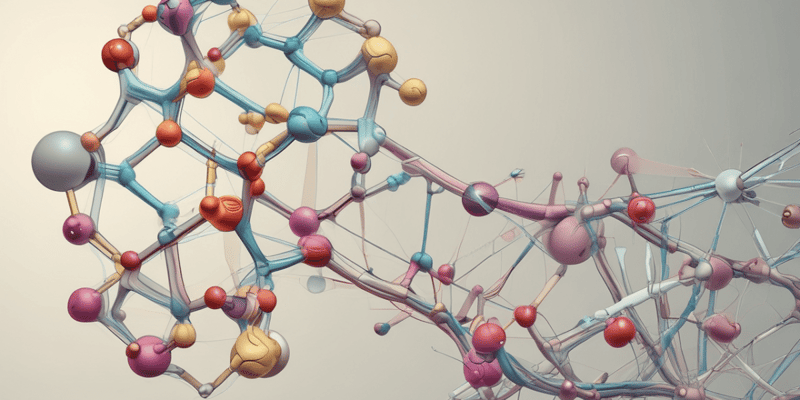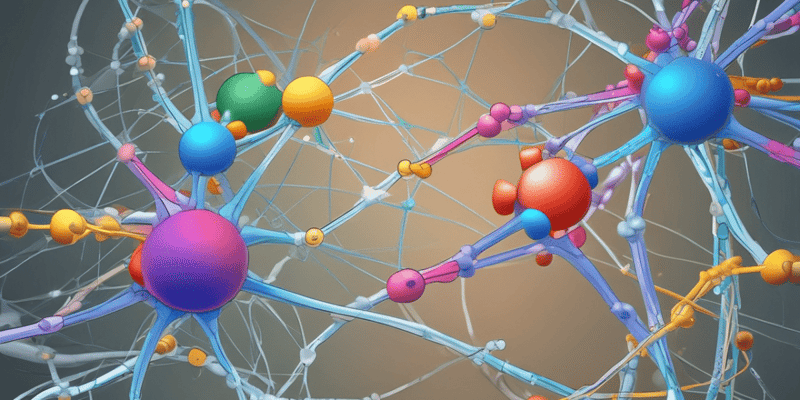16 Questions
What is the role of R groups in protein tertiary stabilization interactions?
Participate in hydrogen bonding, electrostatic interactions, disulfide bonds, and hydrophobic interactions
What type of interaction occurs between cysteine residues in protein folding?
Disulfide bonds
What is the type of bond that forms between peptide bonds in β-sheets and α-helix?
Hydrogen bond
What is the characteristic of an antiparallel β-sheet?
One face polar and one face nonpolar
What is the type of interaction that occurs between aspartate and lysine residues?
Electrostatic interaction
What is the role of helices in the structure of lactate dehydrogenase?
All of the above
What is the characteristic of a parallel β-sheet?
Both faces hydrophobic
What is the name of the coenzyme bound to a site created by the helices in lactate dehydrogenase?
NAD+
What is the function of hemoglobin in the body?
Oxygen transport from lung to tissue
Which of the following genes is located on chromosome 11?
β globin genes
Why can't RBCs synthesize globins?
Because they lack a nucleus
What is the function of myoglobin in the body?
Releasing oxygen at low oxygen pressures
What is the partial pressure of oxygen at which 50% of hemoglobin is saturated?
26 mmHg
Why does hemoglobin exhibit a sigmoidal curve?
Due to cooperative binding
What happens to the oxygen bound to hemoglobin in metabolically active tissue?
It is released
What is the result of the reaction HbO2 + H+ → HbH+ + O2?
Oxygen is released from hemoglobin
Study Notes
Protein Structure
- Salt bridges involve interactions between R groups, such as lysine and aspartate.
- Other tertiary stabilization interactions in protein folding include:
- Hydrogen bonding
- Electrostatic (ionic or salt bridges)
- Disulfide bonds (between cysteines)
- Hydrophobic interactions
Protein Folding
- R groups participate in hydrogen bonding, electrostatic interactions, and hydrophobic interactions.
- Peptide bonds in β sheets and α helix are involved in hydrogen bonding.
Globular Proteins
- Examples: hemoglobin and myoglobin
- Functions:
- Oxygen transport and storage
- CO2 transport
- Buffering – absorbing H+
Hemoglobin and Myoglobin
- Hemoglobin: α globin genes are located on chromosome 16, and β globin genes are located on chromosome 11.
- Red blood cells (RBC) cannot synthesize globins or heme due to the lack of a nucleus and mitochondria.
- ATP is supplied by anaerobic glycolysis, producing lactic acid.
Adult Hemoglobin (HbA)
- Composition: 2α and 2β chains
- Strong hydrophobic interactions between:
- α1 and β1
- α2 and β2
- Weak ionic salt bridges link α1β1 and α2β2 dimers.
Heme Binding
- Proximal histidine (F8, His 93) binds to heme.
- Distal histidine (E7, His 64) binds to oxygen.
Oxygen Binding and Release
- Lung: approximately 100 mmHg
- Tissue: approximately 26 mmHg
- Metabolically active tissue: less than 26 mmHg
- Myoglobin releases oxygen at less than 5 mmHg
- Sigmoidal curve: due to cooperative binding
- P50: partial pressure of oxygen at which 50% of hemoglobin or myoglobin is saturated
- P50 hemoglobin: approximately 26 mmHg
This quiz covers protein structure, including tertiary stabilization interactions, salt bridges, and more, based on Mark's Basic Medical Biochemistry 5th Edition and Harper's Illustrated Biochemistry 30th Edition.
Make Your Own Quizzes and Flashcards
Convert your notes into interactive study material.
Get started for free



